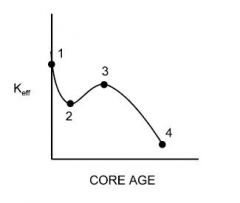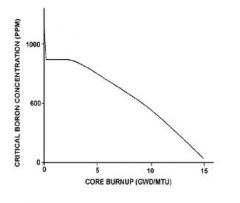![]()
![]()
![]()
Use LEFT and RIGHT arrow keys to navigate between flashcards;
Use UP and DOWN arrow keys to flip the card;
H to show hint;
A reads text to speech;
15 Cards in this Set
- Front
- Back
|
Which one of the following is not a function performed by burnable poisons in an operating nuclear reactor? A. Provide neutron flux shaping. B. Provide more uniform power density. C. Offset the effects of control rod burnout. D. Allow higher fuel enrichment of initial core load.
|
C.
|
|
|
Instead of using a higher concentration of soluble boric acid, burnable poisons are installed in a new nuclear reactor core to... A. prevent boron precipitation during normal operation. B. establish a more negative moderator temperature coefficient. C. allow control rods to be withdrawn farther upon initial criticality. D. maintain reactor coolant pH above a minimum acceptable value.
|
B.
|
|
|
Why are burnable poisons installed in a new nuclear reactor core instead of using a larger reactor coolant boron concentration? A. To prevent boron precipitation during normal operation. B. To establish a more negative moderator temperature coefficient. C. To minimize the distortion of the neutron flux distribution caused by soluble boron. D. To allow the loading of excessive reactivity in the form of higher fuel enrichment.
|
B.
|
|
|
A nuclear reactor is operating near the end of its fuel cycle. Reactor power and reactor coolant system (RCS) temperature are being allowed to "coast down." Why is RCS boron dilution no longer used for reactivity control? A. The reactivity worth of the boron has increased so much that reactivity changes from RCS boron dilution cannot be safely controlled by the operator. B. The reactivity worth of the boron has decreased so much that a very large amount of water must be added to the RCS to make a small positive reactivity addition to the core. C. RCS boron concentration has become so high that a very large amount of boron must be added to produce a small increase in boron concentration. D. RCS boron concentration has become so low that a very large amount of water must be added to the RCS to produce a small decrease in boron concentration.
|
D.
|
|
|
Just prior to a refueling outage, a nuclear power plant is operating at 100 percent power with a reactor coolant boron concentration of 50 ppm. After the refueling outage, the 100 percent boron concentration is approximately 1,000 ppm. Which one of the following is the primary reason for the large increase in full-power reactor coolant boron concentration? A. Reactivity from power defect at beginning of core life (BOL) is much greater than at end of core life (EOL). B. Differential boron worth at BOL is much less than at EOL. [Inverse boron worth at BOL is much greater than at EOL.] C. The excess reactivity in the core at BOL is much greater than at EOL. D. The integral control rod worth at BOL is much less than at EOL.
|
C.
|
|
|
During a six-month period of continuous full power reactor operation, the reactor coolant boron concentration must be decreased steadily to compensate for... A. buildup of fission product poisons and decreasing control rod worth. B. fuel depletion and buildup of fission product poisons. C. decreasing control rod worth and burnable poison burnout. D. burnable poison burnout and fuel depletion.
|
B.
|
|

Refer to the drawing of Keff versus core age for a nuclear reactor core following a refueling outage (see figure below). Which one of the following is responsible for the majority of the decrease in Keff from point 1 to point 2? A. Depletion of fuel B. Burnout of burnable poisons C. Initial heat-up of the reactor D. Buildup of fission product poisons
|
D.
|
|

Refer to the graph of critical boron concentration versus burnup for a nuclear reactor core following a refueling outage (See figure below.). Which one of the following is primarily responsible for the shape of the curve from the middle of core life to the end of core life? A. Fuel depletion B. Fission product buildup C. Burnable poison burnout D. Conversion of U-238 to Pu-239
|
A.
|
|

Refer to the graph of critical boron concentration versus core burnup for a nuclear reactor core during its first fuel cycle (see figure below). Which one of the following explains why reactor coolant critical boron concentration becomes relatively constant early in core life? A. Buildup of fission product poisons is being offset by burnable poison burnout and fuel depletion. B. Burnable poison burnout and fuel depletion are being offset by buildup of fission product poisons. C. Fuel depletion is being offset by the buildup of fissionable plutonium and fission product poison buildup. D. Fission product poison buildup and fuel depletion are being offset by burnable poison burnout.
|
D.
|
|
|
During continuous full-power nuclear reactor operation in the middle of a fuel cycle, the reactor coolant boron concentration must be decreased periodically to compensate for fuel depletion. What other core age-related factor requires a periodic decrease in reactor coolant boron concentration? A. Decreasing control rod worth B. Buildup of fission product poisons C. Burnout of burnable poisons D. Decreasing fuel temperature
|
B.
|
|
|
A nuclear reactor has been operating at 100 percent power for three months following a refueling outage. If the reactor is operated at 100 percent power without making RCS boron additions or dilutions for the next month, RCS boron concentration will... A. decrease because boron atoms decompose at normal RCS operating temperatures. B. decrease because irradiated boron-10 atoms undergo a neutron-alpha reaction. C. remain constant because irradiated boron-10 atoms become stable boron-11 atoms. D. remain constant because irradiated boron-10 atoms still have large absorption cross sections for thermal neutrons.
|
B.
|
|
|
Just prior to a refueling outage the 100 percent power reactor coolant boron concentration was 50 ppm. Immediately following the outage the 100 percent power boron concentration was 1,000 ppm. Assume that burnable poisons were installed during the outage. Also assume that control rods were fully withdrawn from the core at 100 percent power for both cases. Which one of the following contributes to the need for a much higher 100 percent power reactor coolant boron concentration at the beginning of a fuel cycle (BOC) compared with the end of a fuel cycle (EOC)? A. The negative reactivity from burnable poisons is greater at BOC than at EOC. B. The negative reactivity from fission product poisons is smaller at BOC than at EOC. C. The positive reactivity from the fuel in the core is smaller at BOC than at EOC. D. The positive reactivity from a unit withdrawal of a typical control rod is greater at BOC than at EOC.
|
B.
|
|
|
Which one of the following describes whether reactor power can be increased from 50 percent to 100 percent in a controlled manner faster near the beginning of core life (BOL) or near the end of core life (EOL)? (Assume all control rods are fully withdrawn just prior to beginning the power increase.) A. Faster near EOL due to faster changes in boron concentration B. Faster near EOL due to greater control rod worth C. Faster near BOL due to faster changes in boron concentration D. Faster near BOL due to greater control rod worth
|
C.
|
|
|
Which one of the following correctly compares the rates at which reactor power can be safely increased from 80 percent to 100 percent at the beginning of a fuel cycle (BOC) and at the end of a fuel cycle (EOC)? A. Slower at EOC due to a lower maximum rate of reactor coolant boron dilution. B. Slower at EOC due to a less negative control rod worth. C. Slower at BOC due to a lower maximum rate of reactor coolant boron dilution. D. Slower at BOC due to a less negative control rod worth.
|
A.
|
|
|
Compared to adding boric acid to the RCS during forced circulation, adding boric acid during natural circulation requires _________ time to achieve complete mixing in the RCS; and, once completely mixed at a given coolant temperature, a 1 ppm increase in RCS boron concentration during natural circulation will cause a/an ________ change in core reactivity. A. more; smaller B. more; equal C. less; smaller D. less; equal
|
B.
|

